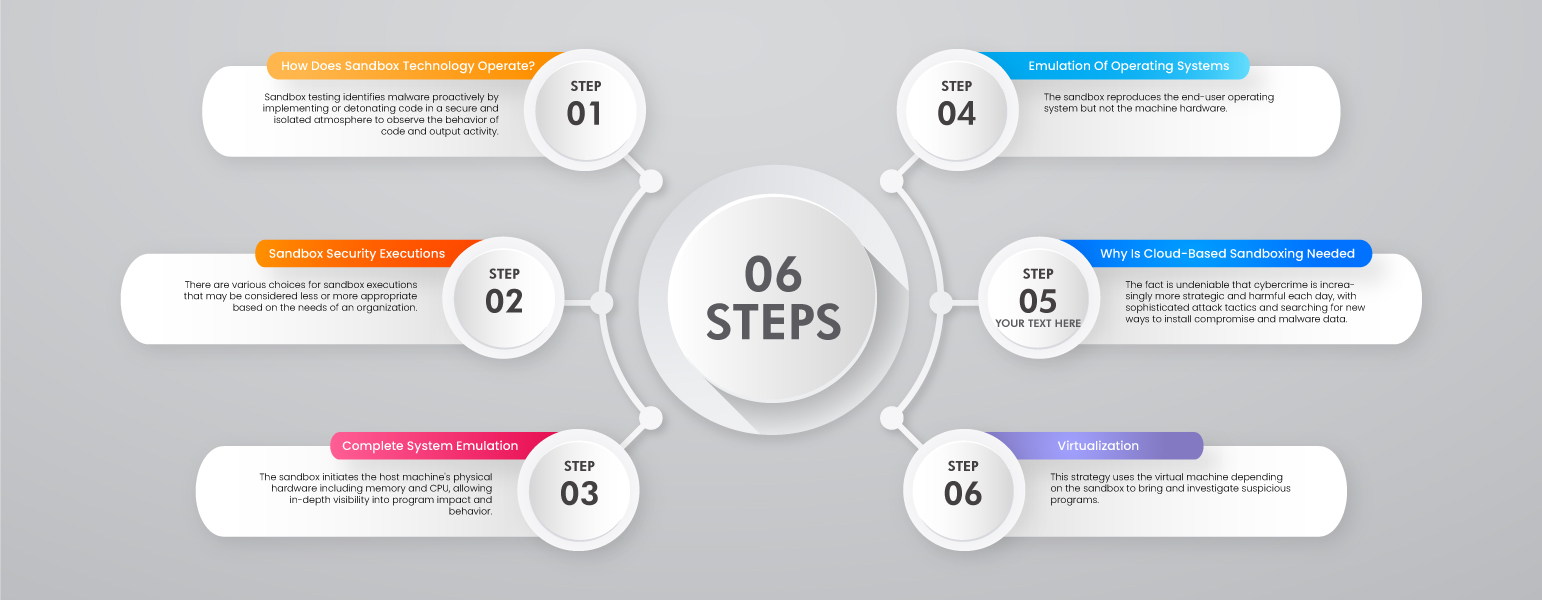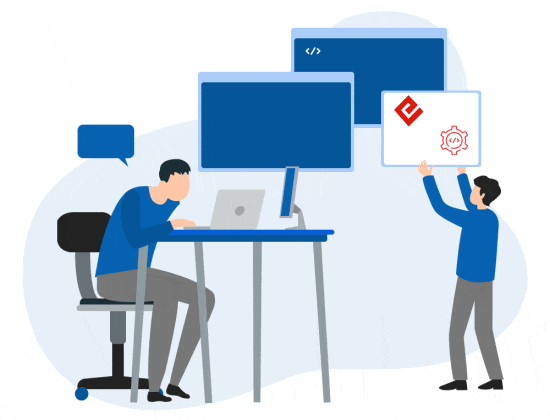In the world of cybersecurity, a sandbox refers to an isolated environment on a network that behaves in end-user operating environments. These are used to securely implement suspicious code without risking harm to the host network or device.
Using a sandbox for the latest malware detection offers another layer of protection in contrast to new security threats, particularly stealthy attacks and zero-day malware. And what occurs in the sandbox keeps in the sandbox, preventing system failures and keeping software vulnerabilities from penetrating.

How Does Sandbox Technology Operate?
Sandbox testing identifies malware proactively by implementing or detonating code in a secure and isolated atmosphere to observe the behavior of code and output activity. Traditional security metrics are reactive and depend on signature detection which performs by watching for patterns found in known circumstances of malware. Because it detects only priority known threats, sandboxes add a layer of security. Additionally, even if a beginner security defense uses artificial intelligence or machine learning, these techniques of defense are only as beneficial as the models strengthening these solutions. There is also a deficiency to complement this solution with the latest malware detection.
Sandbox Security Executions
There are various choices for sandbox executions that may be considered less or more appropriate based on the needs of an organization. Three varieties of sandbox execution include:
Complete System Emulation: The sandbox initiates the host machine’s physical hardware including memory and CPU, allowing in-depth visibility into program impact and behavior.
Emulation Of Operating Systems: The sandbox reproduces the end-user operating system but not the machine hardware.
Virtualization: This strategy uses the virtual machine depending on the sandbox to bring and investigate suspicious programs.
Why Is Cloud-Based Sandboxing Needed?
The fact is undeniable that cybercrime is increasingly more strategic and harmful each day, with sophisticated attack tactics and searching for new ways to install compromise and malware data.
One of the huge challenges in the area of cybersecurity is that small and mid-size businesses come across with keeping operations protected as their dependence on cloud-based internet service grows.
The truth is with over 4.5 billion active internet users at this moment, the internet has instantly become a noticeable platform for attacks. According to recent research from the 2020 Verizon Data Breach Investigations Report, 43% of breaches in 2019 were attacks realized on web applications.
There’s no deficiency of choices to try and steal data. Cybercriminals can enhance access to an organization or individual network by embedding false attachments, URLs, and fields to phishing emails or by planting misleading connections.
The best news is that the latest web security exams like cloud-based sandboxing and protecting web gateways are specially designed to maintain speed with changing email and web threats. For instance, protected web gateways check all bytes of web traffic, even encrypted traffic and utilize cloud sandbox software to investigate suspicious web content for malicious intent.
How Does A Cybersecurity Sandbox Defend Alongside Threats?
A cybersecurity sandbox offers a secure environment for accepting suspicious files, operating an untruth program or installing URLs, with no impact on the devices they are on. It can be used anytime for any circumstance, to protect and investigate a file or code that could be malicious, before serving it up to devices all the while maintaining it isolated from the personal computer and the organization network.
In cybersecurity, sandboxing I considered a resource to investigate that could finish up being categorized as unsafe or safe. Malware becomes more dangerous and prevalent; there are bad applications, connections and installs that could increase access to network data if they are not examined by sandbox software initially. Sandboxing can be utilized as a tool to identify malware attacks and restrict them before adding a network. The system enables IT to test code and have a clear understanding of how it performs before it invades an endpoint device with viruses or malware. It provides the IT team’s insight and techniques on what to watch out for in other scenarios.
As a prime measure in web security and network strategies, sandboxing offers an extra layer of security to realize threats, particularly those from the network to make sure online threats do not compromise operations. The file or application can be run if needed, with all the updates discarded once the sandbox is closed to remove the risk of malicious devices.
What is sandboxing? Sandbox software is accessible as an application and cloud-based solution and provides multiple advantages based on your business requirements.
What Are The Differences Between Cloud-Based And Appliance-Based Sandboxes?
As various SMBs are instantly exposed, cloud-based software allows teams to work productively from any venue very cost-friendly, with no maintenance that on-premise appliances and software need. And that refers to physical on-premise appliance solutions being used less and less, as cloud-based offers benefits for remote working, recovery and backup and decreases in house hardware costs.
While either appliance-based or cloud-based sandboxing software can enhance protection in contrast to zero-day threats, cloud sandboxing provides several benefits for the latest, fast pace workforces in the area of web-based malware inspection scalability, capabilities and ease of use.
Well despite what sandboxing is. Initially, cloud sandboxing removes the requirement for localized servers and allows URLs, code or downloads to be easily tested on the domain in the virtual sandbox, fully separated from the computer or any of the network gadgets. In comparison to on-premise sandboxing that operates on physical applications and cannot secure remote or travelling workers, the expertise to investigate in the virtual environment can secure users on and off the corporate network.
Cloud sandboxing also keeps merit over appliance dependent sandboxing when it comes to inspection abilities as it provides the expertise to inspect malicious web threats, SSL traffic could slip through.
Using cloud sandboxing also removes the requirement for costly investigation appliances that will need maintenance, updates and completely depreciate and cost extra charges.
Which Sandboxing Alternative Is Best For Your Business?
What is sandboxing? Cloud sandboxing is perfect for organizations with a huge network and an abundance of remote workers as it makes certain travelling workers are secured. Cloud-based sandboxes can also scale with the organization whereas appliances will require to be traded in for bigger capacity ones or further items will be required to be purchased. While appliances are not able to sandbox suspicious content from the space, they could be perfect for the smaller organization with the restricted number of endpoint devices that join external, actually the corporate network.
How Does Cloud Sandboxing Maintain The Complete Network From Threats?
IT teams may experience recently the benefits of cloud sandboxing firsthand when coronavirus work from home mandates began, the most notable advantage of cloud sandboxing, in contrast to appliance-based sandboxing, is the capability to safeguard your remote workforce.
For example, with no secured remote work metrics enabled, the remote workers are using several internet web connections from outside networks that can be simply hijacked or utilized for cybercrime due to the huge number of people using these possibly insecure connections. What is sandboxing, The fact is, once a user disconnects with the network they could come up with threats as organization appliances cannot go through with them. The cloud sandbox can safeguard the whole network despite its location. For more remote work security tips, visit our blog page.
How Does Sandboxing Change From The Avast Business Cybercapture Feature?
Cybercriminals concentrate on, for instance, creative schemes to impact a network and influence as many users as potential in a short time frame. One alternative that Avast business endpoint protection solutions have treated for this is through the organization’s proprietary cybercapture file scanning feature, accessible in all Avast business antivirus products.
CyberCapture is specially designed to mechanically identify and analyze suspicious and rare files and utilizes machine learning and attitude analytics to do an in-depth analysis of potential malware. What is sandboxing, it is different then cybercapture as it is utilized to identify flawlessly malicious files that are hidden and capture them for more analysis. In case of detection of malware, cybercapture quarantines and does not move it so it can no longer implement on the system of the user and infect the network.
Such is sandboxing and sandboxing, cybercapture is also performed in the cloud to find malware that utilizes encryption to hide its real sandboxing. Clearing the false code of the creator to expose its authentic commands and instructions. Then it is presented as secure or unsafe and quarantined therefore it is no longer implementable on the device.
While CyberCapture does not need any action to work, it functions automatically, cloud sandboxing can be utilized on demand by any user to the IT team that looks to run a provided file or application in a cloud-based environment isolated from the device.
What is sandboxing? It works alongside cybercapture feeding its insights to cybercapture to allow IT to better detect malicious and non-malicious threats and consistently enhance threat protection.
Learn more: What Are Breach and Attack Simulations?






0 Comments